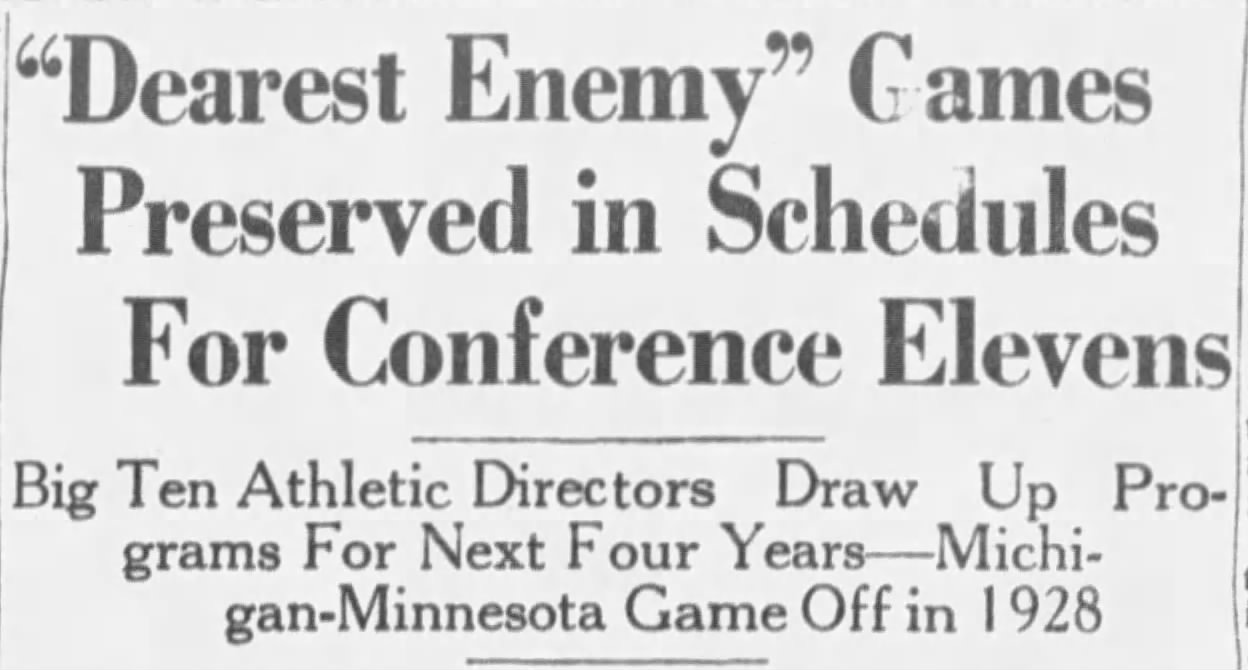Today's Tidbit... Conference Scheduling and Dearest Enemies
Let me know if this sounds familiar. A college athletic conference looking to establish a plan for scheduling conference games seeks to respect longstanding rivalries while finding a way to schedule games among teams with limited history or interest in playing one another.
That may sound like the situation the Big Ten, Big 12, or ACC faces in 2023 as they create rotating schedules with protected rivalries and various forms of pods. Still, the previous sentence summarized the situation the Big Ten faced in 1927 when they first took a stab at coordinated conference scheduling.
Things were different back then because the Big Ten and other conferences were, first and foremost, geared around eligibility standards and not scheduling. The conference did not schedule the games, so Big Ten teams played one another annually or rarely. Minnesota and Wisconsin played one another every year from 1890 to 1927 (other than 1906), while Minnesota and Purdue did not meet from 1898 until 1928, a 30-year stretch against a conference foe when the league had nine or ten teams.
Schools did not play one another due to location, perceived slights, or playing a style of ball considered contemptuous by some (e.g., the Minnesota Shift). The conference determined its champ based on win percentage with ties excluded, with teams required to play four games per year against other conference teams to receive conference championship consideration. Although the four conference games requirement seems easy to reach, some teams struggled to meet the minimum level, resulting in Minnesota and Michigan playing twice in 1927, as did Indiana and Northwestern in 1926.
To remedy the situation, the conference presidents suggested the conference develop multi-year schedules rather than the one or two-year scheduling sequences that were common. The first attempt to do so came at a meeting of conference coaches held the day before the 1926 Army-Navy game in Chicago, a set of meetings Knute Rockne famously attended when his Irish lost to Carnegie Tech while Knute was in the Windy City.
Discussions continued during a January 1927 meeting in Chicago. Then, as now, part of the challenge of conference scheduling was the desire for teams to play their "Dearest Enemies" or rivals every year, and since most teams did not want to exceed the four-game minimum by too many games, the negotiations were complicated.
Making suitable arrangements sometimes forced the breaking of individual contracts. Michigan, for instance, permitted Chicago to break its contract to play four games between 1927 and 1930 so the Maroon could schedule two games apiece with Iowa and Minnesota during those years, ensuring the Hawkeyes and Gophers reached four conference games. Chicago and Michigan then agreed to a new five-year contract starting in 1930.

The conference members ultimately agreed to a four-year schedule, resulting in some schools increasing the number of conference games played each year. Over time, the trend continued until 1983, when the Big Ten first played a round-robin schedule, but they dropped it after the 1984 season.
A round-robin schedule is no longer possible due to the conference's size. Teams also preserve part of the schedule for intersectional games and buy games that provide easy early games and opportunities for Group of Five and FCS programs and players.
Football Archaeology is reader-supported. Click here to buy one of my books or otherwise support the site.


